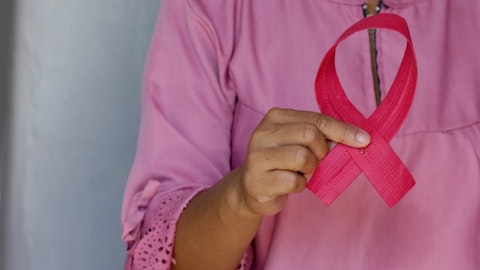BioLineRx Ltd. (NASDAQ:BLRX) Q2 2023 Earnings Call Transcript August 30, 2023
Operator: Ladies and gentlemen, thank you for standing by. Welcome to the BioLineRx Second Quarter 2023 Financial Results Conference Call. All participants are presently in listen-only mode. Following management’s formal presentation, instructions will be given for the question-and-answer session. [Operator Instructions] I would now like to turn over the call to John Lacey, Head of Investor Relations And Corporate Communications. John, please go ahead.
John Lacey: Thank you, operator. Before turning the call over to management, I would like to make the following remarks concerning forward-looking statements. All statements in this conference call, other than historical facts, are indeed forward-looking statements. The words anticipate, believe, estimate, expect, intend, guidance, confidence, target, project and other similar expressions are used typically to identify such forward-looking statements. These forward-looking statements are not guarantees of future performance and may involve and are subject to certain risks and uncertainties and other factors that may affect BioLineRx’s business, financial condition and other operating results. These include but are not limited to, the risk factors and other qualifications contained in BioLineRx’s annual report on Form 20-F, quarterly reports filed in a 6-K and other reports filed by BioLineRx with the SEC to which your attention is directed.
Actual outcomes and results may differ materially from what is expressed or implied by these forward-looking statements. BioLineRx expressly disclaims any intent or obligation to update these forward-looking statements. At this time, it is now my pleasure to turn the call over to Phil Serlin, Chief Executive Officer of BioLineRx.
Phil Serlin: Thank you, John, and good morning, everyone. And thank you for joining us on our second quarter 2023 results conference call today. Earlier this morning, we issued a press release, a copy of which is available in the Investor Relations section of our website. It was also filed as a 6-K. As is our practice, I will begin with an overview, then Mali Zeevi our Chief Financial Officer, will provide a discussion of our financial results. We will then open up the call and are looking-forward to your questions. Also joining the call today for Q&A are Ella Sorani, Chief Development Officer and Holly May, President of BioLineRx USA. Beginning with our lead program, Motixafortide stem cell mobilization for multiple myeloma patients.
We continue to finalize preparations for our upcoming PDUFA target action date of September 9, 2023. If approved, the Motixafortide would formally transition us to a commercial stage company, a very important milestone in our company’s history that would open our future to many additional growth opportunities. Based on the strong efficacy data from the GENESIS Phase 3 clinical trial used to support our NDA application, we believe Motixafortide may play a critical role in addressing unmet needs and could introduce a new treatment paradigm for those with multiple myeloma, who require an autologous stem cell transplant. We believe Motixafortide if approved can provide improved treatment journeys for patients and more certainty for transplant centers, and our commercial team of account directors are actively meeting with payers and reviewing the potential positive benefits of Motixafortide to patients and to the healthcare system.
In preparation for anticipated approval, we have assembled a world-class transplant sales team with fast industry experience in general and multiple years of experience with product launches. They also have multiple years of experience specifically in transplant multiple myeloma and rare disease. Their strong backgrounds and knowledge of the U.S. transplant center community has allowed us to continue to sharpen our commercial launch strategy. We have also substantially advanced supply chain market access and medical affairs activities and are confident that we will be able to launch product soon after potential approval. The U.S. market dynamics for mobilization agents used in stem cell transplants is evolving, but remains strong and growing.
We estimate the overall U.S. market potential at around $300 million with about 50% from Autologous stem cell transplant in multiple myeloma. If approved Metixuportide would be the first true advancement in stem cell mobilization in a decade. With the team that we have assembled, I believe we are incredibly well positioned to capture a significant share of the multiple myeloma transplant market over time. On previous calls, we’ve discussed partnership conversations relating to ex-U.S. development and commercialization Metixuportide and this morning, we were excited to announce the signing of an exclusive license agreement to Metixuportide in Asia alongside a concurrent equity investment. The license agreement includes a $15 million upfront payment plus up to approximately $50 million based on the achievement of specific development and regulatory milestones in China and Japan and up to nearly $200 million in commercial milestones based on defined sales targets.
We are also eligible to receive tiered double-digit royalties on sales. Closing of the transactions is contingent among other things upon approval by the Israeli Innovation Authority of the license agreement within four months of execution, as well as other closing conditions, none of which are related to FDA approval. The agreements were published this morning as part of a separate 6-K. In the area of pancreatic cancer, which is our second major development program for Metixuportide, our clinical program partnerships with Columbia University, and now for the new strategic partnership in Asia announced today, offer the potential to add meaningful and determinative patient data on top of the positive results we’ve seen in our earlier clinical development trials.
As a reminder, our Phase 2a combat COMBAT/KEYNOTE-202 Triple Combination Study of Motixafortide, KEYTRUDA and chemotherapy as a second-line therapy demonstrated substantial improvements across all study endpoints relative to historical data, including overall survival, progression free survival, and overall response rate in the most challenging PDAC patients, all diagnosed with unresectable Stage 4 disease. The combination also appeared to be well tolerated with low incidence of neutropenia and infections in treated patients. As part of our agreement announced this morning, the execution of a randomized Phase 2/3 clinical trial in China is envisioned that will evaluate Motixafortide in combination with a PD-1inhibitor and standard-of-care chemotherapy in first-line metastatic pancreatic cancer.

Copyright: hafakot / 123RF Stock Photo
There is significant unmet need in China in the treatment of pancreatic cancer, and we believe there will be strong physician and patient interest in this clinical evaluation. Additionally, we announced in mid-July the initiation of a randomized investigator initiated Phase 2 clinical trial, sponsored by Columbia University and jointly funded by Regeneron and BioLineRx in first-line metastatic pancreatic cancer based on promising data from single arm pilot phase. The original pilot study enrolled 10 patients and was to be expanded to 30 patients if data from the first 10 were encouraging, which was defined as three or more patients showing partial responses per resist criteria. Following a review of the initial data, the investigators decided to skip the 30 patient single arm expansion and instead move to a larger randomized design.
The amended randomized trial includes 102 patients, and compares the combination of Metixuportide to PD-1 inhibitor cemiplimab and standard-of-care chemotherapy to chemotherapy alone. We anticipate sharing data from the pilot phase at a medical conference in the second-half of this year. We believe the additional data developed from these new partnerships could support larger registrational trial opportunities globally. Needless to say, we are excited about the potential of Metixuportide to form the back mode of new PDAC treatment regimens and give new hope to patients suffering from this very difficult to treat tumor type, while demonstrating the versatility of Metixuportide across both hematological and solid tumor cancers. In parallel with our development work in stem cell mobilization in PDAC, we believe there are additional therapeutic areas where the demonstrated benefits of Metixuportide can be leveraged.
One of these is autologous hematopoietic stem cell based gene therapy for patients suffering from sickle cell disease or SCD, one of the most common genetic diseases globally. To that end, in March, we announced a clinical trial collaboration with Washington University School of Medicine to evaluate Metixuportide in this indication. Unlike multiple myeloma patients, the current standard-of-care mobilization agent GCSF carries significant risks and potential side effects for patients suffering from SCD. Furthermore, in many cases, current mobilization treatments failed to reliably yield optimal numbers of stem cells to facilitate gene therapy. As such this patient population is in urgent need of a new more effective mobilization regimen. Through this collaboration, we plan to conduct a proof-of-concept trial that will study Metixuportide as both a single agent and in combination with the immunomodulator natalizumab.
The study will assess the safety and tolerability of the two regimens as mobilization agents of CD34 positive hematopoietic stem cells in patients with SCD and is anticipated to begin enrollment by the end of this year. I would now like to turn the call over to Mali Zeevi, our CFO, who will give a brief overview of our main financial results. Mali, please go ahead.
Mali Zeevi: Thank you, Phil. As is our practice, in our financial discussion, we will only go over a few significant items on this call, research and development expenses, net loss and cash. Therefore, let me invite you to review the filings we made this morning, which contain our financials 20-F and press release for additional information. Before we get into our review of the quarter, let me remind everyone that this morning’s strategic partnership announcement, described in a separate 6-K, included a $15 million non-dilutive upfront payment related to the license agreement, as well as $14.6 million straight common equity investment. The transaction is subject to formal approval of the license agreement by the Israeli Innovation Authority as well as other closing conditions.
Now to the quarter. Research and development expenses for the three months ended June 30, 2023, were $3 million, a decrease of $2.4 million or 44.3%, compared to $5.4 million for the three months ended June 30, 2022. The decrease resulted primarily from lower expenses related to NDA supporting activities related to Motixafortide, as well as lower expenses associated with the completed AGI-134 clinical trial. Let me now turn to net loss. Net loss for the three months ended June 30, 2023, was $18.5 million, compared to $7.4 million for the three months ended June 30, 2022. The company’s net loss for the six months ended June 30, 2023, amounted to $30.7 million, compared to $12.4 million for the six months ended June 30, 2022. The increase in net loss for both the three and the six months ended June 30, 2023, was due primarily to a non-operating expense of approximately $7.8 million and $10.8 million, respectively, related to the revaluation of outstanding warrants, resulting from an increase in the company’s share price over the preceding three and six months.
The company emphasized that this expense did not impact its cash position as of June 30, 2023, nor its projected cash runway. Now turning to cash. The company held $32.8 million of cash, cash equivalents and short-term bank deposits as of June 30, 2023. Again, this does not include the roughly $30 million in funding from this morning’s strategic partnership announcement nor does it include $30 million available to us under our debt agreement with Kreos Capital, which is tied to the payment of certain milestones. We believe we are well positioned to execute on our operating plans. And with that, I’ll turn the call back over to Phil.
Phil Serlin: Thank you, Mali. In closing, as is our custom, I would like to take a few moments to summarize our key upcoming milestones. First, potential FDA approval of APHEXDA in September 2023. Next, potential U.S. launch of APHEXDA in stem cell mobilization shortly after approval. Initiation of a clinical trial in collaboration with Washington University School of Medicine, to evaluate Metixaportide as monotherapy and in combination with natalizumab for CD34-positive hematopoietic stem cell mobilization for gene therapies in sickle cell disease in the second-half of this year. Initial cohort data from the ongoing Columbia University investigator-initiated study, evaluating Motixafortide in combination with the PD-1 inhibitor LIBTAYO or cemiplimab and standard-of-care chemotherapy in first-line metastatic PDAC patients. With that, we have now concluded the formal part of our presentation. Operator, we will now open up the call to questions.
See also 20 Most Popular Liquor Brands in America and 20 Most Dog Friendly Cities in the US.
Q&A Session
Follow Biolinerx Ltd. (NASDAQ:BLRX)
Follow Biolinerx Ltd. (NASDAQ:BLRX)
Receive real-time insider trading and news alerts
Operator: Thank you. Ladies and gentlemen, at this time we will begin the question-and-answer session. [Operator Instructions] The first question is from Joe Pantginis of H.C. Wainwright. Please go ahead.
Joe Pantginis: Hi, everybody. Good morning and good afternoon. And congratulations on the licensing agreement. Nice to see this external validation. So first, Phil, let me turn first to the upcoming PDUFA date. We all hope it’s going to be positive, obviously. Anything you can share from now about the launch logistics or trajectory regarding how soon do you think you’d be able to launch the drug if it is approved and any sort of rate-limiting catalyst that we need to consider?
Phil Serlin: Yes. So first of all, thanks very much. It’s great speaking to you. I’m going to turn that question over to Holly. Holly, can you take that, please?
Holly May: I would love to take that. So if approved by the FDA, we are ready to enter the market very quickly. So we have all of our supply and distribution setup. We have agreements with the major specialty distributors. We have for the last several months in — a couple of months been out making connections with customers and all stakeholders from the payor level to institutional pharmacists to physicians, nurses, et cetera, and making relationships to build relationships. Not quite yet talking down effect, because obviously, we need approval and label, but we have been building very strong relationships and from a supply and distribution perspective, we are absolutely 100% ready to go. And our intention is to enter the market as quickly as we possibly can. Did that answer your question? Or was there a second part?
Joe Pantginis: Holly, it certainly did. Thank you very much for that. So I’d like to focus now on the Asian partnership and maybe some of the logistics around that. So I guess first, and I apologize, I’ve only gotten through the high level of the 6-K. So I apologize if it’s in there. What is required or time lines for tech transfer and other factors around this agreement? And then also, I know there’s multiple territories considered here, do you have an indication that these territories would accept the FDA approval? Or could there be a particular geographical requirements for, say, a small bridging or confirmatory study? Thank you.
Phil Serlin: Yes. So I’ll take the second part, and I think that Ella, please help me if I’m — if I misspeak in any way. So there are a number of countries in Asia that will rely to a great extent on the FDA approval. And so that the pathway in some of those countries, I’m just throwing out potentially countries like Singapore or perhaps Hong Kong and some other countries, other territories might — it might be much easier to get approval even without a bridging study. On the other hand, there are some countries, and we expect that to be the case in China and perhaps Japan and some of the bigger markets that will probably require some kind of bridging study in order to receive approval. And our partners are planning a development and commercialization plan in stem cell mobilization that will be tailor made for the particular countries that we’re talking about.
As far as what will be required for a tech transfer, as we mentioned, there are a number of smallish closing conditions that we have to meet, including the Israeli Innovation Authority approval. The 6-K has some additional information regarding it. We need to appoint a director. They’re going to have a representative on our Board of Directors and some other smaller closing conditions. Once the closing is complete, and I hope that, that will be done sometime in the next three to four weeks, hopefully, by the end of Q3, then we will set about — we already have a draft commercial — I’m sorry, development plan for pancreatic cancer, for example, as part of the agreement, and that — we will start to execute on that and provide whatever technology transfer we need, and they will start to put together the necessary regulatory submissions et cetera in order to move forward in the development plan.
Joe Pantginis: That’s very helpful. And then one last, if you don’t mind. In fact, I’m going to quote some of your prepared comments where you say as is customary. So as is customary, I’m going to ask the question I ask all the time. So can you provide any guidance or body language as to the maturity of discussions in other territories?
Phil Serlin: Body language, you’re very funny. I will just say, as I’ve said before, we are laser focused on the U.S. right now. We are — obviously, we brought a deal right now in Asia. And so I can’t say that we’re not speaking to other parties as well. And we are obviously interested in maximizing the value of Motixafortide throughout the world. So we are continuing to discuss in other territories. But our focus right now is on the launch and on the approval. And we’re only talking right now a PDUFA date of less than 10 days away. So right now, I think that we’ve got a lot on our plate right now between the tech transfer that’s necessary for the Asian market and the launch in the U.S. I think that once we successfully reach those objectives, we will start to turn to other territories as well on a more intensive basis.
Joe Pantginis: Absolutely. I really appreciate all the color, Phil and good luck coming into the PDUFA.
Phil Serlin: Thank you very much.
Operator: The next question is from John Vandermosten of Zacks. Please go ahead.
John Vandermosten: Thank you and hello, everyone. Let me to start with a question on the kind of continuum in the partnership in Asia. I know there were two entities there, and I just want to look the relationship between those and how that might help with the development and commercialization?
Phil Serlin: Yes. So the — there is no direct relationship. At this point, we — the primary development partner is Gloria Biosciences and the investor group so to speak, is a company called Hang Seng Technology. They’re not affiliated at this time.
John Vandermosten: Okay. And what experience do these guys have in terms of commercial — commercializing already in the region, do they have a lot of other products under their belt and how have they’ve done with that? Do they have a good process that they’ve put into place for that?
Phil Serlin: Yes. So Gloria Biosciences actually has an approved PD-1 in China. And they have received approval in two indications. And I believe that they have launched that product. I don’t know on the top of my head what their revenues are right now. But like I said, they do have an approved PD-1 in China that has been launched already. I will also point out just parenthetically that the PD-1 that — their PD-1 in China they have greater China rights for that. And the rest of world rights are held by Arcus Biosciences and Gilead Sciences, who are running a number of studies global and otherwise, with the PD-1 is called ZIM in — for the rest of the world. So this is — actually, their PD-1 is quite robust, and there’s a very significant development plan, both in China and globally for this PD-1.
John Vandermosten: Okay. So they might use a local PD-1 as a combination rather than another one?
Phil Serlin: Yes, they’re going to use their approved PD-1, correct for the combination in pancreatic cancer, correct.
John Vandermosten: Okay. And congratulations on the partnership and the upfront investment. So obviously, that’s almost $30 million there. Does that help you avoid having to take on any other tranches in the Kreos Capital? Or do you think you will still need that? And I guess this is also a question on just the expected cash burn to be over the next quarter?
Phil Serlin: Yes. So that’s a good question. I mean we — obviously, this is a very significant strengthening of our balance sheet. It provides us on a pro forma basis with over $60 million in cash and puts us in a really good position to continue to execute on our launch and on the rest of our programs without having any significant stress. We have a lot of optionality, I’d have to say, between what we have on our balance sheet and the Kreos Capital loan. And so we feel very comfortable right now going into launch whether we have — we really do have plenty of capital to go forward. We haven’t given the guidance right now because we have — this is so new. We haven’t had a chance to update our forecast. But I believe that this will give us adequate capital way past launch and into the latter half of 2024, if not beyond.
Our current burn rate, I think you asked, is somewhere in the $7.5 million to $10 million per quarter depending right now, we’re in launch mode. We’re in prelaunch mode and there is a lot of very heavy lifting that has to be done. I think it would probably settle out to closer to the $7 million to $8 million range going forward once we’ve completed all the heavy lifting in connection with the launch.
John Vandermosten: Okay, great. Thank you, Phil.
Phil Serlin: No problem.
Operator: There are no further questions at this time. Before I ask Mr. Phil Serlin to go ahead with his closing statement, I would like to remind participants that a replay of this call is scheduled to begin two hours after the conference. In the U.S. please call 1 (888) 295-2634. In Israel, please call (03) 925-5904. Internationally, please call 9723-9255-904. Mr. Serlin, would you like to make your concluding statements?
Phil Serlin: Yes. Thank you, operator. In closing, we are progressing through 2023 with significant momentum. We are preparing for the potential U.S. approval of our first therapy in stem cell mobilization and we are ready for commercial launch. We have worked to strengthen our balance sheet through the strategic relationship announced today, made significant advancements in our pancreatic development program and further positioned Motixafortide for development in Asia for stem cell mobilization indications. We have also taken important additional life cycle management steps by entering into a collaboration to execute a clinical trial with the Motixafortide as a mobilization agent in gene therapies. I’m extremely pleased with our progress during the second quarter, and I’m excited about what we are in the process of achieving this year. I want to thank you all very much for your continued interest in BioLineRx. Be safe, and have a great day.
Operator: Thank you. This concludes the BioLineRx Investor Relations Call. Thank you for your participation. You may go ahead and disconnect.
Follow Biolinerx Ltd. (NASDAQ:BLRX)
Follow Biolinerx Ltd. (NASDAQ:BLRX)
Receive real-time insider trading and news alerts



